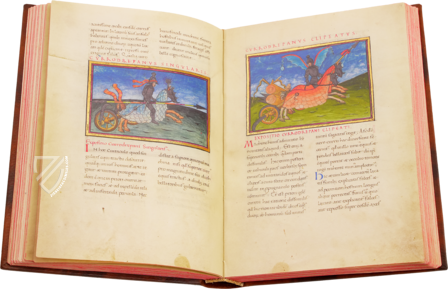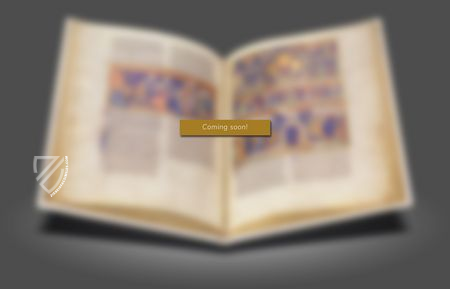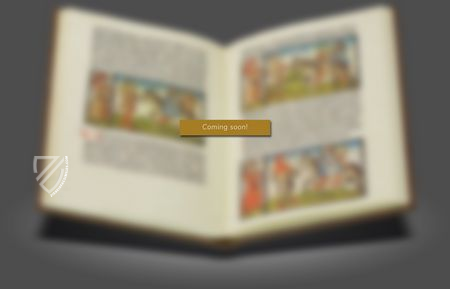Notitia Dignitatum
(3,000€ - 7,000€)
The famous ledger for the management of the Roman Empire from late-antiquity in a 15th century manuscript! The manuscript with the title Descripto orbis terrarium of the Spanish National Library’s manuscript collection contains the famous Notitia Dignitatum as well as eleven additional treatises on thematic areas that are administratively, politically, geographically, topographically, and historically interesting. In this way, the compendium, which has been known in this form since the 9th century, presents an exciting mix of texts from various epochs, authors, and themes. As a special feature, a few of the texts are illustrated with gorgeous miniatures that are always typical for the respective period. A unique, comprehensive glimpse into history!
Notitia Dignitatum
The famous ledger for the management of the Roman Empire from late-antiquity in a 15th century manuscript! The manuscript with the title Descripto orbis terrarium of the Spanish National Library’s manuscript collection contains the famous Notitia Dignitatum as well as eleven additional treatises on thematic areas that are administratively, politically, geographically, topographically, and historically interesting. In this way, the compendium, which has been known in this form since the 9th century, presents an exciting mix of texts from various epochs, authors, and themes. As a special feature, a few of the texts are illustrated with gorgeous miniatures that are always typical for the respective period. A unique, comprehensive glimpse into history!
Exciting Historical Treatises
The manuscript with the signature Ms. Reserva 36 of the Biblioteca Nacional de España in Madrid bears the title Descripto orbis terrarium. The manuscript collects texts about geography, topography, politics, and other themes on 336 pages. This historically significant compendium was already compiled in this form in the 9th century. In the 15th century, this was reproduced in the finest detail for the Madrid codex. 12 treatises altogether – among them the Cosmography of Pseudo-Aethicus, texts about the cities of Rome and Constantinople, and a dispute between Hadrian and Epictetus - give wonderful insight into various historically interesting thematic areas.
The Administration of the Roman Empire
The most famous of the twelve treatises in the manuscript is undoubtedly the so-called Notitia Dignitatum (Notitia dignitatum tam civilium quam militarium): a Roman state ledger, originating from the beginning of the 5th century. It contains a description of the administrative structure of the Roman Empire along with a depiction of the personalities and office holders who were responsible for managing Roman sovereignty. This valuable information about the management structure of the Roman Empire, about the military and political mastery of such a large area, was continuously referred to over the centuries. Thus, Charlemagne himself relied upon the Notitia Dignitatum and formed the organization of his empire according to its rules.
Miniatures in the Flux of the Ages
The Madrid manuscript originated in Italy. The Italian humanists of the 15th century concerned themselves extensively with political and cosmological treatises. The texts in this manuscript are true to the originals and are gorgeously illustrated with over 100 miniatures. These are obliged by the respective taste and style of the text’s period of origin. Therefore, one finds elegant Gothic miniatures and lavish Renaissance adornment, but also schematic charts in the tradition of the Early Middle Ages, or well-arranged tables. Ancient personalities on coins, personifications and symbolic depictions of cities and regions, as well as other depictions illustrate the historically significant text of this manuscript!
Codicology
- Size / Format
- 336 pages / 28.8 × 20.8 cm
- Origin
- Italy
- Date
- 15th century
- Epochs
- Style
- Language
- Script
- Humanistic minuscule
- Illustrations
- Over 100 miniatures in gold frames, numerous colorful decorative initals with gold leaf
Notitia Dignitatum
BALISTA QVADRIROTIS
As the greatest engineers of the ancient world, the Romans also created sophisticated weapons of war such as the Carroballista, a cart-mounted type of mobile field artillery. They were adopted in the 1st century AD and are depicted on the triumphal columns of both Trajan and Marcus Aurelius. The 4th century Roman general Vegetius tells us that each cart was drawn by two armored mules or horses, operated by ten soldiers commanded by an officer, and that each legion had 55 – one per century.

Notitia Dignitatum
ITALIA, ILLIRICUM, AFRICA
Depicted as three female saints with halos, the three most important provinces of the Western Roman Empire are presented in a lovely miniature with a rich color palette and the judicious use of gold leaf: Italy, Illyria, and Africa. The women are depicted with typified faces and are dressed in similar flowing garments, each holding a basket of bread.
Being the original province and home to the capital, Italy was naturally the most important province in the West. Situated between the Adriatic Sea and the Danube River, Illyria was critical both strategically and as a recruiting ground for the legions. Africa was, except for Italy, the richest province in the West and an important source of grain for the great cities of the empire.

#1 Notitia Dignitatum
Language: Spanish
(3,000€ - 7,000€)
- Treatises / Secular Books
- Apocalypses / Beatus
- Astronomy / Astrology
- Bestiaries
- Bibles / Gospels
- Chronicles / History / Law
- Geography / Maps
- Saints' Lives
- Islam / Oriental
- Judaism / Hebrew
- Single Leaf Collections
- Leonardo da Vinci
- Literature / Poetry
- Liturgical Manuscripts
- Medicine / Botany / Alchemy
- Music
- Mythology / Prophecies
- Psalters
- Other Religious Books
- Games / Hunting
- Private Devotion Books
- Other Genres
- Afghanistan
- Armenia
- Austria
- Belgium
- Colombia
- Croatia
- Cyprus
- Czech Republic
- Denmark
- Egypt
- Ethiopia
- France
- Germany
- Greece
- Hungary
- India
- Iran
- Iraq
- Israel
- Italy
- Japan
- Lebanon
- Luxembourg
- Mexico
- Morocco
- Netherlands
- Palestine
- Peru
- Poland
- Portugal
- Russia
- Serbia
- Spain
- Sri Lanka
- Sweden
- Switzerland
- Syria
- Turkey
- Ukraine
- United Kingdom
- United States
- Uzbekistan
- Aboca Museum
- Ajuntament de Valencia
- Akademie Verlag
- Akademische Druck- u. Verlagsanstalt (ADEVA)
- Aldo Ausilio Editore - Bottega d’Erasmo
- Alecto Historical Editions
- Alkuin Verlag
- Almqvist & Wiksell
- Amilcare Pizzi
- Andreas & Andreas Verlagsbuchhandlung
- Archa 90
- Archiv Verlag
- Archivi Edizioni
- Arnold Verlag
- ARS
- Ars Magna
- ArtCodex
- AyN Ediciones
- Azimuth Editions
- Badenia Verlag
- Bärenreiter-Verlag
- Belser Verlag
- Belser Verlag / WK Wertkontor
- Benziger Verlag
- Bernardinum Wydawnictwo
- BiblioGemma
- Biblioteca Apostolica Vaticana (Vaticanstadt, Vaticanstadt)
- Bibliotheca Palatina Faksimile Verlag
- Bibliotheca Rara
- Boydell & Brewer
- Bramante Edizioni
- Bredius Genootschap
- Brepols Publishers
- British Library
- C. Weckesser
- Caixa Catalunya
- Canesi
- CAPSA, Ars Scriptoria
- Caratzas Brothers, Publishers
- Carus Verlag
- Casamassima Libri
- Chavane Verlag
- Christian Brandstätter Verlag
- Circulo Cientifico
- Club Bibliófilo Versol
- Club du Livre
- CM Editores
- Collegium Graphicum
- Collezione Apocrifa Da Vinci
- Comissão Nacional para as Comemorações dos Descobrimentos Portugueses
- Coron Verlag
- Corvina
- CTHS
- D. S. Brewer
- Damon
- De Agostini/UTET
- De Nederlandsche Boekhandel
- De Schutter
- Deuschle & Stemmle
- Deutscher Verlag für Kunstwissenschaft
- DIAMM
- Droz
- E. Schreiber Graphische Kunstanstalten
- Ediciones Boreal
- Ediciones Grial
- Ediclube
- Edições Inapa
- Edilan
- Editalia
- Edition Deuschle
- Edition Georg Popp
- Edition Leipzig
- Edition Libri Illustri
- Editiones Reales Sitios S. L.
- Éditions de l'Oiseau Lyre
- Editions Medicina Rara
- Editorial Casariego
- Editorial Mintzoa
- Editrice Antenore
- Editrice Velar
- Edizioni Edison
- Egeria, S.L.
- Eikon Editores
- Electa
- Emery Walker Limited
- Enciclopèdia Catalana
- Eos-Verlag
- Ephesus Publishing
- Ernst Battenberg
- Eugrammia Press
- Extraordinary Editions
- Fackelverlag
- Facsimila Art & Edition
- Facsimile Editions Ltd.
- Facsimilia Art & Edition Ebert KG
- Faksimile Verlag
- Feuermann Verlag
- Folger Shakespeare Library
- Franco Cosimo Panini Editore
- Friedrich Wittig Verlag
- Fundación Hullera Vasco-Leonesa
- G. Braziller
- Gabriele Mazzotta Editore
- Gebr. Mann Verlag
- Gesellschaft für graphische Industrie
- Getty Research Institute
- Giovanni Domenico de Rossi
- Giunti Editore
- Graffiti
- Grafica European Center of Fine Arts
- Guido Pressler
- Guillermo Blazquez
- Gustav Kiepenheuer
- H. N. Abrams
- Harrassowitz
- Helikon
- Hendrickson Publishers
- Henning Oppermann
- Herder Verlag
- Hes & De Graaf Publishers
- Hoepli
- Holbein-Verlag
- Hortus Deliciarum
- Houghton Library
- Hugo Schmidt Verlag
- Idion Verlag
- Il Bulino, edizioni d'arte
- ILte
- Imago
- Insel Verlag
- Instituto Nacional de Antropología e Historia
- Istituto dell'Enciclopedia Italiana - Treccani
- Istituto Ellenico di Studi Bizantini e Postbizantini
- Istituto Geografico De Agostini
- Istituto Poligrafico e Zecca dello Stato
- Italarte Art Establishments
- J. Thorbecke
- Jan Thorbecke Verlag
- Johnson Reprint Corporation
- Josef Stocker
- Josef Stocker-Schmid
- Jugoslavija
- Karl W. Hiersemann
- Kasper Straube
- Kaydeda Ediciones
- Kindler Verlag / Coron Verlag
- Kodansha International Ltd.
- Konrad Kölbl Verlag
- Kurt Wolff Verlag
- La Liberia dello Stato
- La Linea Editrice
- La Meta Editore
- Lambert Schneider
- Landeskreditbank Baden-Württemberg
- Leo S. Olschki
- Les Incunables
- Library of Congress
- Libreria Musicale Italiana
- Lichtdruck
- Lito Immagine Editore
- Lumen Artis
- Lund Humphries
- M. Moleiro Editor
- Maison des Sciences de l'homme et de la société de Poitiers
- Manuscriptum
- Martinus Nijhoff
- Maruzen-Yushodo Co. Ltd.
- MASA
- McGraw-Hill
- Militos
- Millennium Liber
- Müller & Schindler
- Nahar and Steimatzky
- National Library of Wales
- Neri Pozza
- Nova Charta
- Oceanum Verlag
- Odeon
- Orbis Mediaevalis
- Orbis Pictus
- Österreichische Staatsdruckerei
- Oxford University Press
- Pageant Books
- Parzellers Buchverlag
- Patrimonio Ediciones
- Pattloch Verlag
- PIAF
- Pieper Verlag
- Plon-Nourrit et cie
- Prestel Verlag
- Princeton University Press
- Prisma Verlag
- Priuli & Verlucca, editori
- Pro Sport Verlag
- Propyläen Verlag
- Pytheas Books
- Quaternio Verlag Luzern
- Reales Sitios
- Recht-Verlag
- Reichert Verlag
- Reichsdruckerei
- Riehn & Reusch
- Roberto Vattori Editore
- Rosenkilde and Bagger
- Roxburghe Club
- Salerno Editrice
- Sarajevo Svjetlost
- Schöck ArtPrint Kft.
- Scolar Press
- Scrinium
- Scripta Maneant
- Scriptorium
- Siloé, arte y bibliofilia
- SISMEL - Edizioni del Galluzzo
- Sociedad Mexicana de Antropología
- Société des Bibliophiles & Iconophiles de Belgique
- Soncin Publishing
- Sorli Ediciones
- Stainer and Bell
- Studer
- Styria Verlag
- Sumptibus Pragopress
- Szegedi Tudomànyegyetem
- Taberna Libraria
- Tarshish Books
- Taschen
- Tempus Libri
- Testimonio Compañía Editorial
- Thames and Hudson
- The Clear Vue Publishing Partnership Limited
- The Facsimile Codex
- The Folio Society
- The Marquess of Normanby
- The Richard III and Yorkist History Trust
- Tip.Le.Co
- TouchArt
- TREC Publishing House
- TRI Publishing Co.
- Trident Editore
- Typis Regiae Officinae Polygraphicae
- Union Verlag Berlin
- Universidad de Granada
- University of California Press
- University of Chicago Press
- Urs Graf
- Vallecchi
- Van Wijnen
- VCH, Acta Humaniora
- VDI Verlag
- VEB Deutscher Verlag für Musik
- Verlag Anton Pustet / Andreas Verlag
- Verlag Bibliophile Drucke Josef Stocker
- Verlag der Münchner Drucke
- Verlag für Regionalgeschichte
- Verlag Styria
- Vicent Garcia Editores
- W. Turnowsky
- Waanders Printers
- Wiener Mechitharisten-Congregation (Wien, Österreich)
- Wissenschaftliche Buchgesellschaft
- Wydawnictwo Dolnoslaskie
- Xuntanza Editorial
- Zakład Narodowy
- Zollikofer AG














































